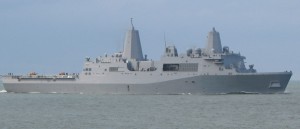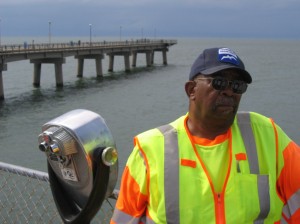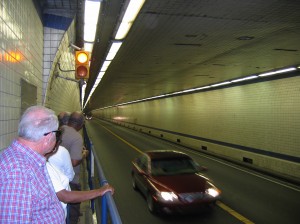Tuesday, September 6, 2011, promised to be a memorable day what with the tour by our US Coast Guard Auxiliary Cape Charles 12-02 Unit of one of the great engineering marvels of the modern world, the amazing 17 mile long Chesapeake Bay Bridge-Tunnel complex. Our group gathered at the north end of this transportation wonder which is so important to the economy of the Eastern Shore of Virginia as it connects our area, which is the southern tip of the DELMARVA peninsula, to the mother ship, mainland Virginia. There we all were ushered into the wood panelled meeting room of the complex’s Board of Directors and seated in plush leather swivel chairs at an immense, polished mahogany conference table where we were warmly greeted by Mr. Jeff Holland, the executive director of the complex and his assistant Paige Addison. Jeff took great pains to explain to us the history of the Bridge-tunnel from its inception all the way through its construction, carefully illustrating with a slide show its ground-breaking engineering. As well, we learned about its ongoing maintenance, its operation, considerations for future improvements, its funding and security issues. As one who has driven across this complex countless times, even during extreme weather events and electrical outages, and even having been rescued by their emergency personnel, I was amazed by the quality and quantity of new information I gathered.

Jeff Holland, Executive Director of the CBB-T, points out the Thimble Shoals Channel of the bridge-tunnel to Milton Hickman, son of a former longtime director of the complex.
Our group was then given toll passes to allow us to travel south over the bridges and through both tunnels to park on the first island near the restaurant and visitor’s center. Jeff took time to point out the massive construction of the islands and the bridge trestles, and pointing out to us the shipping channels that the underground tunnels span. Observation points on the island afford visitors and travelers an incredible perspective of the mouth of the Chesapeake Bay where it meets the Atlantic Ocean. Also, there is a fishing pier that has special lighting underneath that attracts schools of bait fish to the surface, making the pier a great attraction for fishermen casting from the pier above them. While we were observing this incredible scene, Jeff pointed out to us a very special ship making her way east through the Thimble Shoals Channel. She is the USS New York, a US Navy warship, which was built with steel salvaged from the site of the World Trade Center after its destruction on September 11, 2001. How poignant that we should be touring this facility just a few days before the tenth anniversary of that event just as she was passing by.

USS New York passes through the Chesapeake Bay Bridge-Tunnel on her way to the tenth memorial anniversary of the destruction of the World Trade Center on Sept. 11, 2001.
Next, our group was lead into the garage bay of the island’s ventilation and maintenance building where we were informed by the director of safety, Mr. Jim Davis, of how the public is protected by their extensive traffic safety procedures and response to breakdowns and accidents. It seemed that every conceivable emergency has been considered and planned for, which spoke so highly of the professionalism and dedication of the employees of the Bridge-tunnel.

Traffic Safety Director Mr. Jim Davis, in front of fishing pier, explains the complex's focus on safety.Inside the ventilation and control b uilding on the first island.
Re-climbing and catching our breath, our group re-entered the ventilation building with a big sigh of relief. And then we climbed one more story up where we could walk above the tunnel’s traffic lanes in the ventilation shafts. Ventilating the tunnels is essential to removing the carbon monoxide produced by the traffic and the huge fans exchange the air every few minutes. Up in the ducts above the tunnels, the space is pitch black dark but through the vents in the ceiling, we could watch the traffic passing below us!
Tags: Chesapeake Bay Bridge Tunnel, DELMARVA peninsula, Eastern Shore of Virginia, life on Virginia's Eastern Shore, U.S. Coast Guard Auxillary, Virginia Eastern Shore
